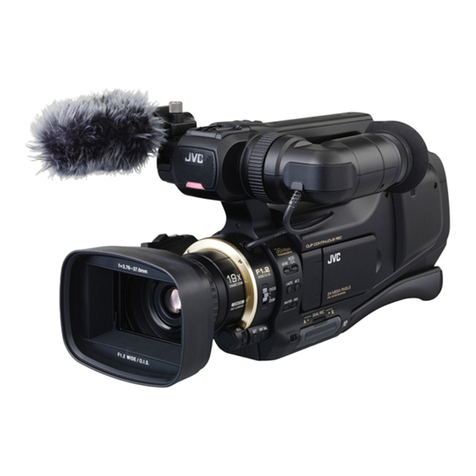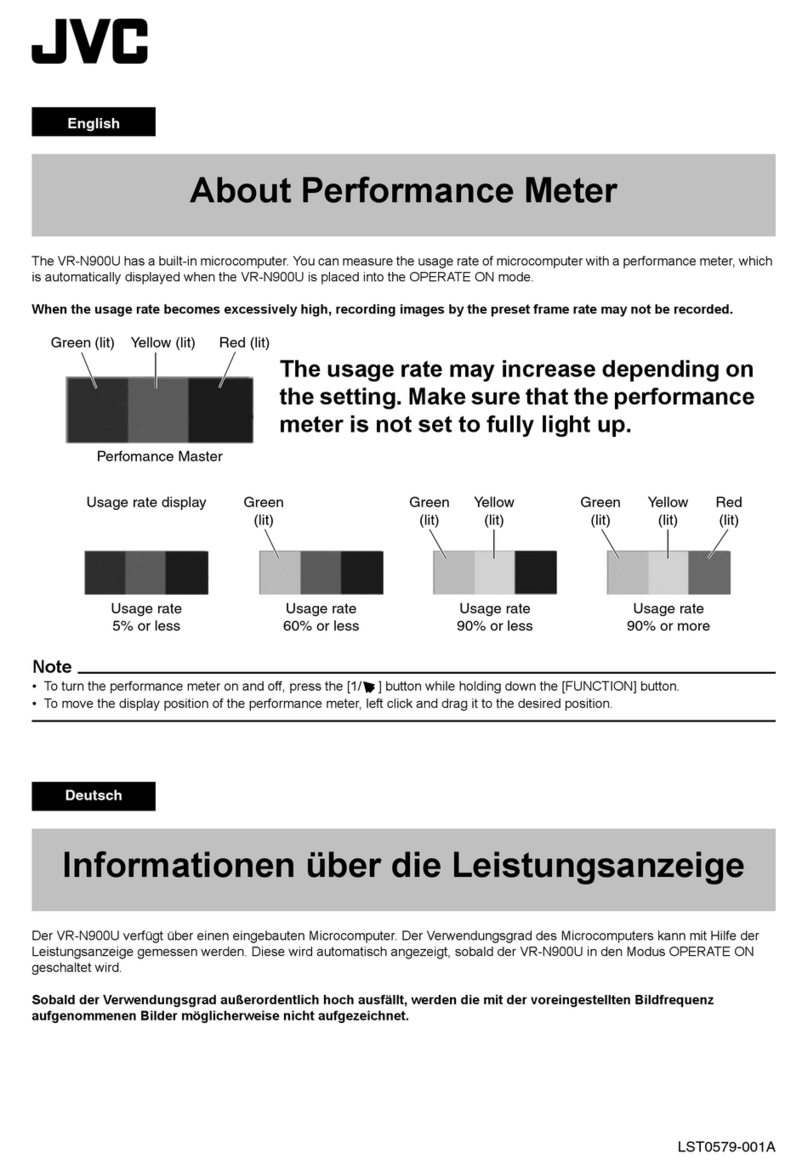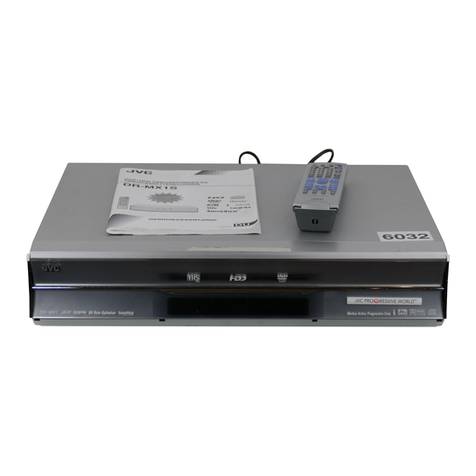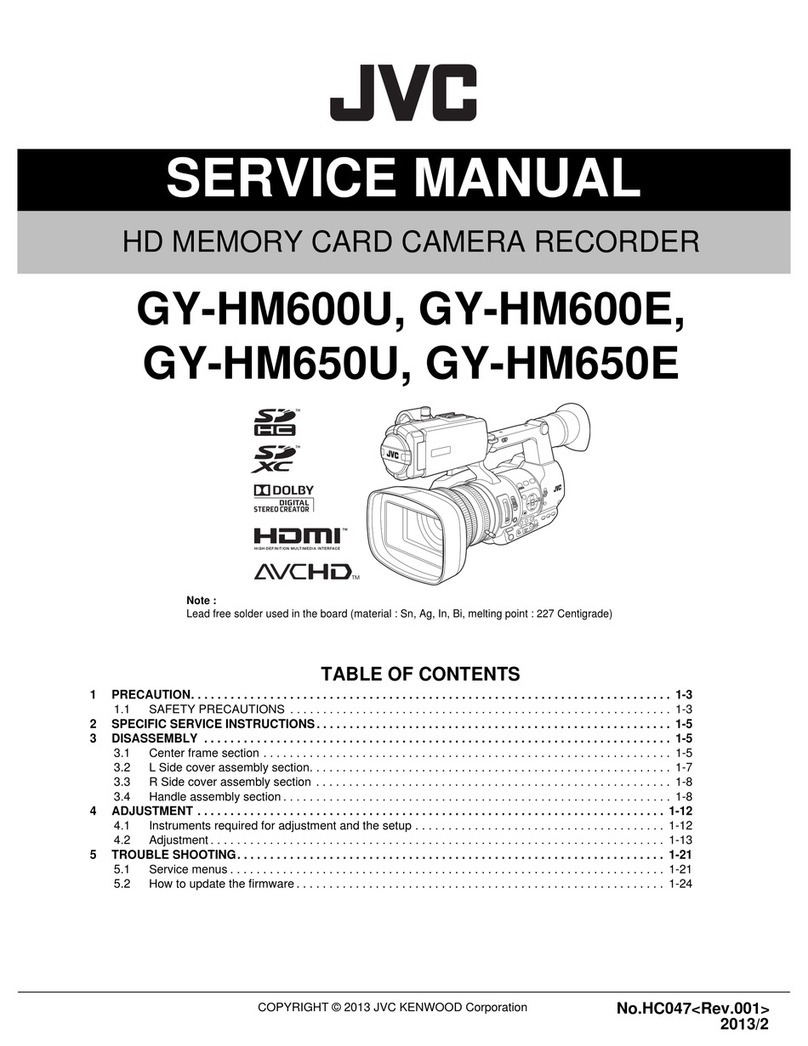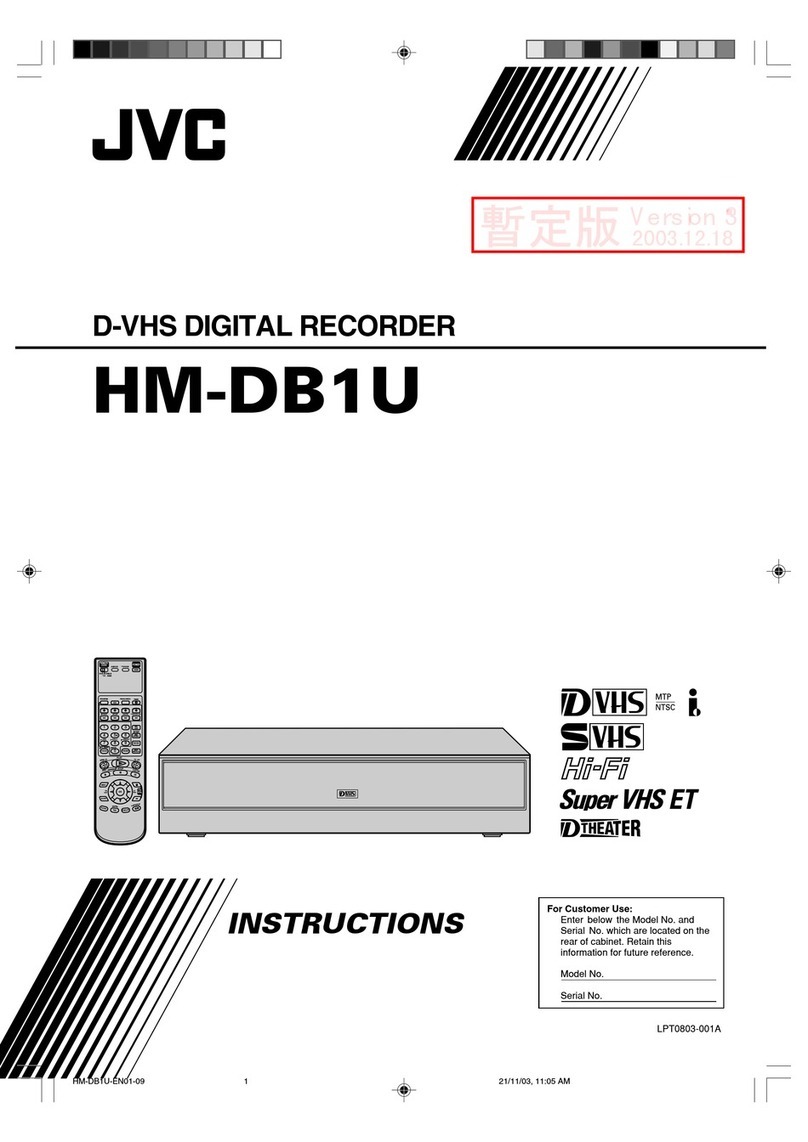
SR-S365U
has
been
changed
to
SR-S365U(A)
since
the
serial
No.
xx3x7659
and
after.
The
mechanism
assembly
has
been
changed
to
an
aluminum
die-cast
and
the
main
board
assembly
has
been
changed
as
well.
To
distinguish
the
new
model
from
the
senventional
models,
a
label
printed
(A)
is
attached
after
the
model
No.
of
the
rating
label
(Serial
No.
label)
and
the
front
panel.
This
service
manual
only
explains
the
changed
sections,
therefore,
to
carry
out
the
services
for
the
(A)
version,
please
refer
to
the
manual
for
the
SR-S365U
(No.
9330)
as
well.
Section
Title
Page
Section
Title
Page
Important
Safety
Precautions
2.5.4
EP
auto
tracking
CHECK
«00...
sees
eteteteereeiereeeneereetes
2-21
SECTION
1
SERVICE
CAUTION
2.5.5
Tension
arm
position
check/adjustMent
.......
eee
2-22
2.5.6
Take-up
torque
CHECK
o......
ce
ceeeceecceeceenreeerensatenensensane
2-22
1.1
DIFFERENCE
BETWEEN
SR-S365U
AND
SR-S365U(A)
...........
1-1
2.5.7
Tape
transport
system
check/adjustment
........
eee
2-22
SECTION
2
MECHANISM
REPAIR/ADJUSTMENT
PROCEDURES
2.1
BEFORE
MAKING
REPAIR/ADJUSTMENT
......ceeeeeeeeerteetereees
2-1
2.1:4
PRECAUTIONS
.....vecceesvinescdesetssovescseestcevesteoreeenees
2-1
2.1.2
How
to
unload
the
cassette
tape
manually
2-1
2.1.3
Special
implements
and
Tools
Required
for
Adjustment
........
2-1
2.1.4
Specifications
of
alignment
tape
2-1
2.2
MAINTENANCE
AND
CHECK
uo...
eeeceeeerees
2-2
2.2.1
Location
of
main
mechanical
parts
2-2
2.2.2
Maintenance
of
main
parts
and
periodical
FOTENON
COs,
ors.
aint
ote
cucssh
ideas
vender
wacet
eee
vs
ote
Seat
y
ena
nee
2-3
2.2.3
Cleaning
.....
2-4
2:2:4
>
LUDTICATIONS
si..cceeedsiesieegaranten
an
2-4
2.3
REPLACEMENT
OF
MAIN
PARTS
..........
ahs
2-4
2.3.1
Before
reMOVING
....
ce
ececeeseesseseesereceeseeserieerseeneeerseneeenen®
2-4
2.3.2
How
to
set
to
the
mechanism
assembly
POSITION
Ae
ca ia
eee
Ra
ancl
eit
Nahas
2-4
2.3.3
Stator
Assembly
...
2-4
2.3.4
Rotor
Assembly
............
wi
2-
2.3.5
Upper
drum
assembly
....
wide
2.3.6
Head
cleaner
oe
2
2.3.7
Pinch
roller
arm
assembly
.
we
2.3.8
Tension
band
asSeEMbly
........cccceeceeteeeeeeeeeeeeees
wide
2.3.9
Capstan
motor,
Capstan
brake
arm
assembly
...
aide
2:38:41
ON
DIuM-ASSOMDNY
2.3...
isccis,weceesecsecsceetaa
viet
raupeceresstesdiaovtesd
2-
2.3.11
Clutch
unit
(S),
(T),
Control
plate,
Reel
disk
(S),
(T).........
2-
2.3.12
Fullerase
head
2...
lee
eceseeceeeceeeeeteesneerseeeensenseseeee
2-10
2.3.13
A/C
head
assembly
.
iach
Soede
sck
ae
PaaMee
2-10
2.3.14
Belt
(LOadING)
..........ccccccssesecssecseserecstsestessesessrsesnceeseeses
2-10
2.3.15
Belt
(Capstan,
HOUSING)
«0...
ce
celeeseeseeteeeaseeereeteees
2-11
2.3.16
Idler
assembly
...........
ee
Sesh
AMOR,
2-11
2.3.17
Sub
brake
assembly
(7)
.....
ae
we
211
2.3.18
Sub
brake
assembly
(S)
.........
Lrbtedeitbewi
slvcdee
Sees
2-11
2.3.19
Pole
base
assembly(S),
(T)
.... ence
Ree
nee
2-12
2.3.20
Guide
flange(S),
(T)
......
sEfleiiess
Deen
ibid
2-12
2.3.21
Guide
arm
assembly
..........-
siledavasedeeseleexstn
suas
2-13
2.3.22
Loading
motor,
Motor
pulley
wo...
cece
eseesereereeneenees
2-13
2.3.23
Rotary
encoder,
Control
Cam
......ceccceeeeeeeeeteestseeteeeens
2-13
2.3.24
Slide
plate,
Main
brake
assembly(S),
(T)
«0...
eee
2-14
2182
5
SIICGISK(S):
(Dic
cbsces
esac
cbevaeass
Ave
cevatnda
vishe
en
cuce Pies
ceeds
2-15
2.3.26
Guide
rail,
Loading
arm
assembly
...........:::eesseceeeeeeeeeee
2-15
2.3.27
Pulley
AaSSOMDIY
0...
cece
eecsecseeceerecseeeecnseeseeentoneee
2-16
2.3.28
Worm
gear
aSSEMbIy
.......ceeeeceececsecenceeeeeeneeeeeeeeeseeeneeene
2-17
2.4
HOW
TO
MOUNT
THE
MAIN
PARTS
(Mechanism
Phase
Adjustment)
.00.....0..cceeeeeeseereeeeeteerenees
2-17
2.4.1
Before
parts
assembling
..........
beast
Dod
2.4.2
Loading
arm
assembly
(S),
(T)
oc.
eee
eeeeeeseeeseeeeeeeeneeeee
2-17
2.4.3
Rotary
encoder,
Change
lever,
Control
cam
..
we
2718
24.4.
“SWS:
Plate...
sctecseccze
cidene
sce
cesdedeckeceee
cna
dnadavevecpsodzscstesers
2-18
2:45.
Control
plate.
sie
sec
sitivdcadeceee
tdi
ele
ees
2-18
2.5
INTERCHANGEABILITY
ADJUSTMENT
........eeeeseesesreererneeers
2-19
2.5.1
FM
waveform
linearity
check/adjustment
..........
2-19
2.5.2
A/C
head
assembly
height,
Azimuth
CHECK/ACUSTIMISN
Tica
ssivsses
scecesevesssescesenehbeecseccesvss
destuesse
2-20
2.5.3
A/C
(Audio
Control)
head
phase
(X
value)
check/
AG/USTMEN
Ty
ote
een
ele
Meera
eeu
oie,
of
2-21
OYUYdhodoa
SECTION
3
ELECTRICAL
ADJUSTMENT
3:1
PRECAUTION.
nn.
echissectn
calidon.
Hen
Ghee
ae
diane
cai
iiice
3.1.1
Required
test
equipment
.......
3.1.2
Required
adjustment
tools
....
3.1.3
About
board
adress
0...
cece
seeeeeeseereeemeeenaees
3.1.4
Signals
required
for
video
system
adjustment
.
3.2
SWITCHING
REGULATOR
CIRCUIT
....
3.2.1
5V
DC
output
voltage
...........
3.3
SERVO
CIRCUIT
oo...
eee
ee
3.3.1.
PB
switching
point
.........
3.3.2
Slow
tracking
preset
......
3.4
VIDEO
CIRCUIT
wee
eee
3.4.1
AGC
Y
level
ou.
aviuies
3.4.2
White/dark
clip
(S-VHS/VHS)
.
3.4.3.
Sub
emphasis
input
level
.........
3.4.4
Carrier/deviation
(S-VHS/VHS)
..
3.4.5
PB
Y
level
(S-VHS/VHS).....
3.4.6
SP/EP
REC
color
level
.......
3.4.7
S-VHS
VIDEO
EQ.
...........
3.4.8
AFC
CLOCK...
bout
3.5
PRE/REC
CIRCUIT
......
3.5.1
REC-FM
level
...
fis
3.6
AUDIO
CIRCUIT
oo.
eee
3.6.1
Audio
REC
FM
level
.......
3.6.2
Audio
EE
level
3.7
Y/C
SEP
CIRCUIT.........
3.7.1
Digital
I/O
level
BOOONNNYNN
SSS
5>
a
a
WW
WD
WD
WW
WOO
WW
WW
OO
WW
WW
WW
WOO
AHOdHAROOGEK
SECTION
4
CHARTS
AND
DIAGRAM
4.1
OVERALL
WRING
DIAGRAM
.....0...ccceccsceeserseeeteeseeeecsersesenaenes
4-1
4.2
MAIN
(SYSCON)
CIRCUIT
BOARD
SCHEMATIC
DIAGRAM...
cece
cece
terseneesereneeenetsesasseneeneeess
42
4.3
MAIN
(SERVO)
CIRCUIT
BOARD
SCHEMATIC
DIAGRAM
uu...
eee
cece
cecenseeerenssensnecnsreeteeneeess
4-3
4.4
MAIN
(VIDEO)
CIRCUIT
BOARD
SCHEMATIC
DIAGRAM...
cece
ee
cccecssetseereenseceeseseessseecseneesees
4-4
4.5
MAIN
(AUDIO)
CIRCUIT
BOARD
SCHEMATIC:
DIAGRAM
.....
oc
ceeecccteeteeeecreseesecsereeceeseeeresaneesenaes
4.6
MAIN
CIRCUIT
BOARD
0.0...
.ccecceccccceteetseeteertereeneenes
pisetrcedans
4.7
FG
AMP
CIRCUIT
BOARD
SCHEMATIC
DIAGRAM...
4.8
FG
AMP
CIRCUIT
BOARD
.......c
ccc
cceeeeteereeneeeeenes
4.9
IC
BLOCK
DIAGRAMS.
.......
cscs
eesccccteesetsenseseesessetecneeuseneensessnes
SECTION
5
EXPLODED
VIEWS
AND
PARTS
LIST
5.1
CABINET
AND
CHASSIS
ASSEMBLY
MMI]
o.oo.
eceteeenees
5-1
5.2
CABINET
AND
CHASSIS
ASSEMBLY
PARTS
LIST
stereetgese
DAZ
5.3
MECHANISM
ASSEMBLY
(MILA)
0...
ce
ceccecceeeeseeeeesetseeeee
we
BS
5.4
MECHANISM
ASSEMBLY
PARTS
LISTT
MI4)
oe
5-3
SECTION
6
ELECTRICAL
PARTS
LIST
6.1
MAIN
BOARD
ASSEMBLY
PARTS
LIST
(0113)
oe
6-2
6.2
FG
AMP
BOARD
ASSEMBLY
PARTS
LIST
(1I6)
oe
6-7















